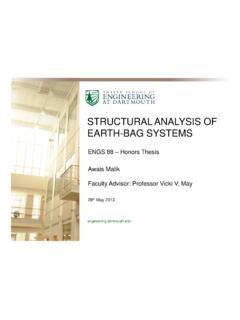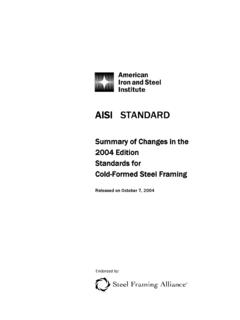Transcription of Structural Resistance of Earthbag Housing
1 Structural Resistance of Earthbag Housing Subject to Horizontal Loading Student: Chris Croft Supervisor: Dr Andrew Heath Department of Architecture and Civil Engineering The University of Bath 2011 AR40223 MEng dissertation i Abstract Earthbag Housing is a recent development that offers a low cost and low carbon Housing solution. Little is known of the Structural performance of Earthbag Housing and this paper seeks to address this by investigating the Resistance of Earthbag structures to horizontal loading. Walls have been tested by applying loading longitudinally and perpendicular to the length, and comparisons have been made with theoretical models. The contribution to strength of different variables used in conventional design has been examined.
2 It was found that the addition of cement render provided the greatest improvement both in strength and stiffness and for both directions. For variables other than render, the serviceability limit state was defined as the most critical. Theoretical models for the in-plane loading showed good correlation with the experiments, although imperfect modelling resulted in erroneous predictions for the failure mode of walls subject to out-of plane loading. ii Acknowledgements Great gratitude is extended to Dr. Andrew Heath for his enthusiastic support and guidance throughout this research project. Dr Michael Patterson also provided the know-how on areas less familiar to the author and this proved highly valuable. The author would also like to thank the laboratory staff who included Will Bazeley, Neil Price, Brian Purnell, Graham Mott and Sophie Hayward.
3 A fantastic effort was made to achieve a large number of experiments in such a short space of time. One last thank you is for Ellen. Although not familiar to the world of earthbags before, she has provided great support in producing this contribution. iii Table of contents 1 Introduction .. 1 Earthbag house design and principles .. 2 Advantages and Disadvantages of Earthbag Construction .. 2 Existing codes of practice and previous research .. 2 Context and aims of research .. 3 2 Literature Review .. 4 Earthbag Theory .. 4 Earthbag Experiments .. 5 Literature of indirect relevance .. 8 Conclusion .. 9 3 Theory .. 10 Behavioural and mechanical assumptions .. 10 Wall design and testing models .. 10 Strength of walls in flexure .. 12 Strength of walls in shear .. 17 4 Laboratory Testing.
4 23 Materials .. 23 Wall tests .. 24 5 Results & Analysis .. 27 Materials .. 27 Flexural test results .. 30 Analysis of flexural behaviour .. 36 Shear test results .. 39 Analysis of shear behaviour .. 45 6 Discussion .. 48 Validity of results .. 48 Implications of experimental results .. 48 Recommended Future Studies .. 49 7 Conclusion .. 50 iv List of Figures Figure 1 Earthbag Domes at Cal Earth .. 1 Figure 2 Earthbag dome section (left) and Earthbag wall under shear (right) .. 3 Figure 3 Free body diagrams of rectangular Earthbag model (left) and semi-circular model (right) (Tantono, 2007) .. 4 Figure 4 Predicted shear failure mode of earthbags in a dome structure subject to a line load (Vadgama, 2010) .. 5 Figure 5 Compression test (left) and arch test (right), Pelly (2010) and Vadgama (2010).
5 6 Figure 6 Shearbox tests (left) and accompanying results (right), Pelly (2010) .. 7 Figure 7 Shear test setup, Lohani (2006) .. 7 Figure 8 Failure envelope and Mohr s circle plotted by Lohani (2006) .. 8 Figure 9 Linear Earthbag house wall design, longitudinal section (left) and transverse section (right) (Hunter and Kiffmeyer, 2004) .. 11 Figure 10 Model walls to be tested in shear (left) and flexure (right) without render or barbwire .. 11 Figure 11 Assumed bag dimensions and properties .. 12 Figure 12 Flexural wall with shear force diagram and bending moment diagram .. 13 Figure 13 Deflected shape for flexural wall with single (left) and twin (right) applied loads . 14 Figure 14 Failure envelope for wall with 1kN normal load per bag .. 15 Figure 15 Horizontal load, H, against normal load, N, for a 1m high single bag wall.
6 15 Figure 16 State of stress for masonry unit under shear and normal loading with unfilled head joints .. 18 Figure 17 Stepped sliding failure .. 19 Figure 18 Failure envelope for plain shear wall model .. 21 Figure 19 Movement of barbwire in wall under shear .. 21 Figure 20 Horizontal section through rendered wall showing render infill and steel ties .. 22 Figure 21 Assumed path for crack in render (left) and force equilibrium (right) .. 22 Figure 22 Flexural test setup .. 25 Figure 23 Shear test setup .. 26 Figure 24 Tensile load vs. extension for bag material tensile and tearing tests .. 28 Figure 25 Horizontal load vs. mid-span displacement for flexural wall tests .. 31 Figure 26 Horizontal load vs. mid-span displacement for flexural tests enlarged .. 32 Figure 27 Tensile crack (left) and compression cracking (right).
7 33 Figure 28 'Plain B': Initial and final state (left) lateral displacement vs. horizontal load plot (right) .. 34 Figure 29 'Barbwire': Initial and final state (left) lateral displacement vs. horizontal load plot (right) .. 34 Figure 30 Reinforced: Initial and final state (left) lateral displacement vs. horizontal load plot (right) .. 35 Figure 31 Stabilised: Initial and final state (left) lateral displacement vs. horizontal load plot (right) .. 35 Figure 32 Rendered: Initial and final state (left) lateral displacement vs. horizontal load plot (right) .. 36 Figure 33 Horizontal load vs. normal load for all shear tests .. 39 Figure 34 Initial shape (left) and final shape (right) for plain' model test cycle 4 .. 40 Figure 35 Compression of bags up to render infill (left) and separation of bags from render (right).
8 41 Figure 36 Result of photogrammetric analysis for 'plain' with average total normal load of (cycle 1 on graph below) .. 42 Figure 37 H/N vs. top course displacement for plain wall (incl. self weight) .. 42 v Figure 38 H/N vs. top course displacement for barbwire wall .. 43 Figure 39 Result of photogrammetric analysis for 'barbwire' with average total normal load of (cycle 1 on graph below) .. 43 Figure 40 H/N vs. top course displacement for rendered wall .. 44 Figure 41 Final image of rendered wall at failure .. 44 Figure 42 The steel reinforcement used in the rendered shear wall (shown in order) .. 46 Figure 43 Dry sieve analysis of fill material .. 53 Figure 44 Stress vs. strain for barbwire tensile tests .. 53 Figure 45 Typical cross section of render prism used in flexural test .. 54 Figure 46 Applied load vs.
9 Strain for DEMEC marker groups .. 55 List of Tables Table 1 Bag tensile test results .. 27 Table 2 Bag tearing test results .. 28 Table 3 Barbwire tensile test results .. 29 Table 4 Render test results and measurements .. 29 Table 5 Summary of flexural test results .. 30 Table 6 Comparison between theoretical and experimental strengths of flexural walls .. 36 Table 7 Comparison between theoretical and experimental strengths of 'plain' walls .. 45 Table 8 Render compression and flexural test results .. 54 Table 9 Steel reinforcement axial tension test results .. 54 Table 10 DEMEC Stain gauge results .. 55 vi List of Symbols A Contact area between two bags Area of cross-section b Bag width Effective cohesion Modified effective cohesion h Bag height H Horizontal load Horizontal failure load Horizontal bending failure load Horizontal shear failure load Irender Second moment of area of render Ixx Second moment of area of section Ka Active earth pressure (of fill)
10 Assumed crack length in render Length of bag material in cross-section Length between top of wall and top lateral load L Bag length M Applied moment n Number of bags above failure plain N Applied vertical force t Thickness of render T Tension force in bag material w Earthbag weight y Distance to extreme fibres of section Distance to centroid of area Coefficient of friction Modified coefficient of friction Minimum normal stress Vertical stress Normal stress in the x direction Normal stress in the y direction Stress due to bending Tensile stress Maximum tensile stress Maximum tensile stress in render Maximum shear stress and Shear stress Pattern interlocking factor 1 1 Introduction Earthbag Housing is an intriguing innovation, which is becoming increasingly relevant in a carbon-conscious and still developing world.










